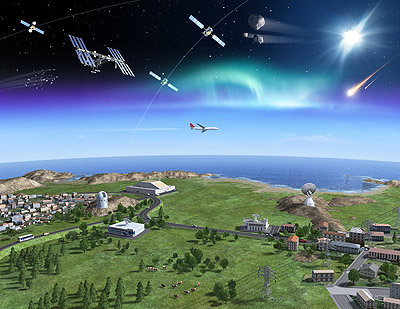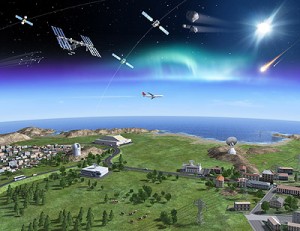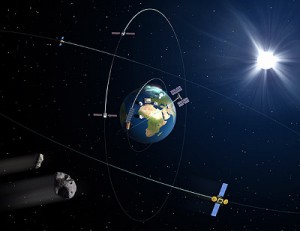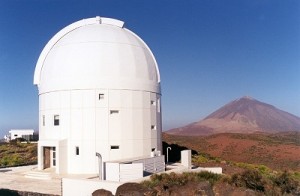

Artist's impression showing how radars, telescopes and networks on the ground can work in unison to detect space hazards including debris in orbit, harmful space weather and near-Earth objects (Credits: ESA - P. Carrill).
Source ESA: Strong agreement was voiced on the need for Space Situational Awareness (SSA) by delegates representing a wide range of European-level and national stakeholders at an SSA seminar in Warsaw while exchanging views and ideas on the future direction of Europe’s capabilities. As part of an extensive six-month programme of political, cultural and scientific initiatives during Poland’s tenure in the Presidency of the Council of the EU, the country’s Ministry of Economy hosted a special seminar devoted to Space Situational Awareness (SSA) on 29 September in Warsaw. The event was co-sponsored by ESA and aimed at fostering discussions on defining Europe’s future SSA capabilities. The strong level of interest and participation made it one of the largest such gatherings to date. Some 150 delegates representing a wide range of stakeholders – including the European Commission, the European External Action Service, European-level institutions such as the European Defence Agency, national governments – including the US Department of State – and space agencies, industry, Eumetsat and ESA – gathered for a full day of presentations and discussions.
Europe needs SSA capability

Artist's impression of the three main 'segments', or areas of activity, for SSA: space surveillance and tracking of debris objects (SST), detecion of space weather (SWE) and searching for near-Earth objects (NEOs) - (Credits: ESA - P. Carrill).
“We saw all key European stakeholders involved in SSA in Warsaw,” said Nicolas Bobrinsky, Head of ESA’s SSA Preparatory Programme. “There was strong agreement across scientific, industrial, technical and policy lines that Europe needs its own SSA capability.”
Based on ESA’s long experience in space operations, and as part of the SSA Preparatory Programme, launched in 2009, ESA is taking the first steps toward the development of precursor services and an infrastructure that will ultimately enable Europe to autonomously detect, predict and assess risks to life and property. These risks could be from man-made space objects, reentries, in-orbit explosions and collisions, disruption of missions and satellite-based service capabilities, potential impacts of Near-Earth Objects, and the effects of space weather on space- and ground-based infrastructure.
Satellites affected by space weather and debris hazards
Delegates presented a wealth of data showing the critical need for up-to-date information on the space environment. Telecommunication, navigation, scientific and observation satellites in orbit can all be affected by space weather caused by the Sun, while orbital debris can threaten operational satellites (see the Space Situational Awareness profile video 2011 below). “We had about 30 warnings of possible collisions with debris objects in the past year, four of which were high risk for MetOp-A. We had our first collision avoidance manoeuvre on 1 May 2011,” said Michael Williams, Head of Eumetsat’s Control Centre Division. Terje Wahl, of the Norwegian Space Centre, presented numerous examples of how geomagnetic storms caused by space weather can seriously affect a range of civil and commercial activities: “These range from polar navigation, polar commercial flights and tourism to undersea oil exploration and drilling, which relies on precise magnetic-compass navigation.”
Cooperation for SSA

ESA's Optical Ground Station (OGS)is located at the Observatorio del Teide on Tenerife, and is situated at an altitude of 2393 metres (Credits: ESA).
And the problems that SSA seeks to solve are not small. According to the European Commission (see link), the quantifiable estimated loss for European assets due to collisions with debris and the effects of space weather amount to some €332 million per year, on average. “The future direction of Europe’s SSA capability is under active discussion in a number of European-level forums,” said Géraldine Naja, Head of the ESA Director General’s Office for EU Relations. “These include the ESA/EU Space Council and the ongoing series of ‘Structured Dialogue’ meetings, which bring together ESA, the European Commission, the EU Council, the European External Action Service, the European Defence Agency and the European Union satellite Centre. In 2011 to date, we’ve already met twice. Cooperation in many areas related to SSA is now under way.”
“For us, the event confirmed that steps for an overall European SSA capability need to be undertaken in an efficient and economic manner, which requires the linking of existing national assets to a European SSA network,” said Nicolas Bobrinsky. “In line with the 2008 Space Council resolution, the European Commission and the EU Council share responsibility for defining the SSA governance and data policy, which now must be clarified. “Some of the processes used in ESA Member States may prove useful as models.”
Originally published by ESA on October 5, 2011.
Video below: ESA Space Situational Awareness profile video 2011.

















































































































![A trajectory analysis that used a computational fluid dynamics approach to determine the likely position and velocity histories of the foam (Credits: NASA Ref [1] p61).](https://www.spacesafetymagazine.com/wp-content/uploads/2014/05/fluid-dynamics-trajectory-analysis-50x50.jpg)



Leave a Reply